Argenteuil
Argenteuil (French pronunciation: [aʁʒɑ̃tœj]; ![]()
Argenteuil | |
|---|---|
Subprefecture and commune | |
.jpg) The Pont d'Argenteuil over the River Seine | |
.svg.png) Coat of arms | |
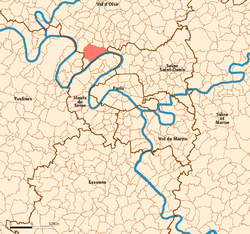 Location (in red) within Paris inner and outer suburbs | |
Location of Argenteuil 
| |
 Argenteuil Location (in red) within Paris inner and outer suburbs 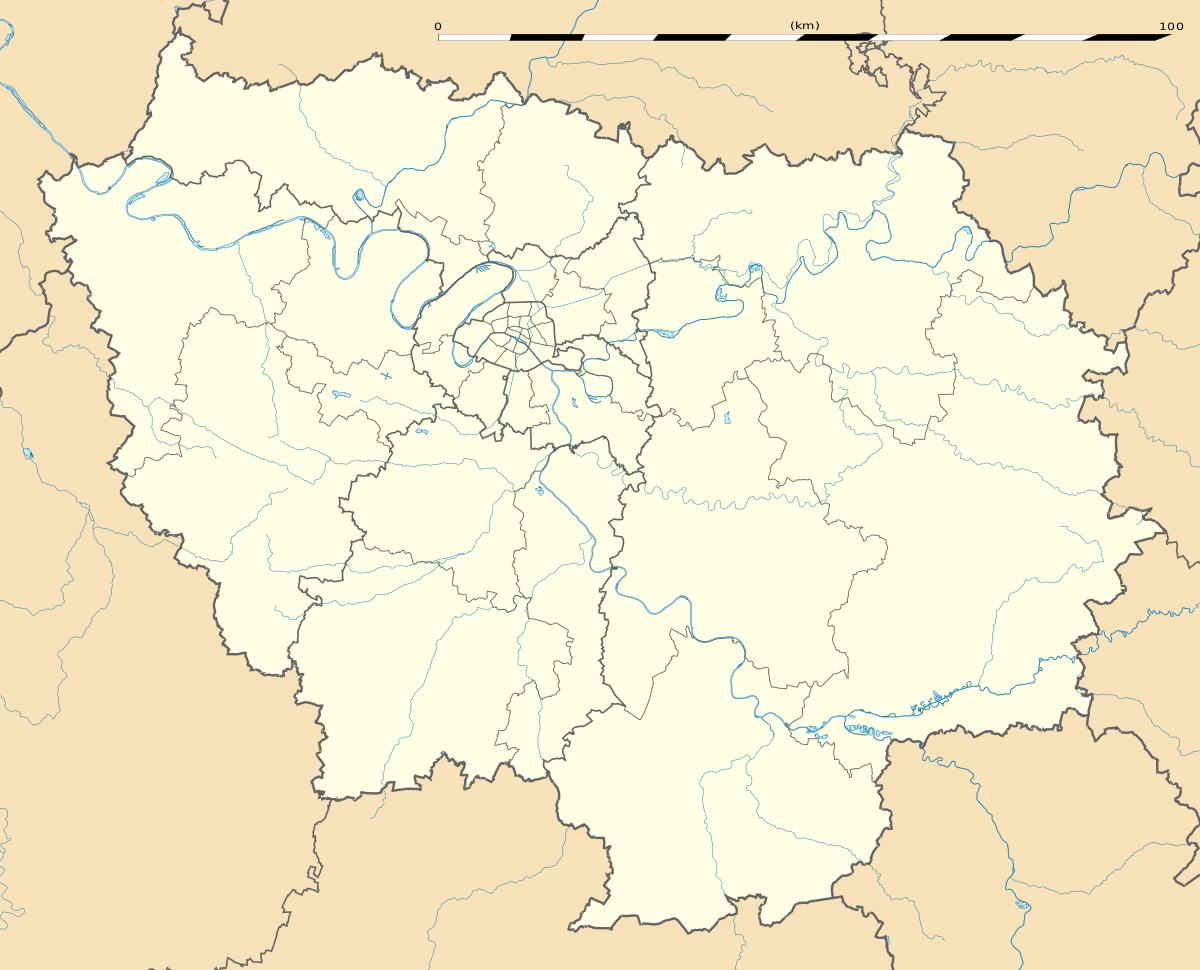 Argenteuil Argenteuil (Île-de-France (region)) | |
| Coordinates: 48°57′00″N 2°15′00″E | |
| Country | France |
| Region | Île-de-France |
| Department | Val-d'Oise |
| Arrondissement | Argenteuil |
| Canton | Argenteuil-1 Argenteuil-2 Argenteuil-3 |
| Intercommunality | Métropole du Grand Paris EPT Boucle Nord Seine |
| Government | |
| • Mayor (2014-2020) | Georges Mothron |
| Area 1 | 17.22 km2 (6.65 sq mi) |
| Population (2017-01-01)[1] | 110,210 |
| • Density | 6,400/km2 (17,000/sq mi) |
| Time zone | UTC+01:00 (CET) |
| • Summer (DST) | UTC+02:00 (CEST) |
| INSEE/Postal code | 95018 /95100 |
| Elevation | 21–167 m (69–548 ft) |
| 1 French Land Register data, which excludes lakes, ponds, glaciers > 1 km2 (0.386 sq mi or 247 acres) and river estuaries. | |
Argenteuil is the second most populous commune in the suburbs of Paris (after Boulogne-Billancourt) and the most populous one in the Val-d'Oise department, although it is not its prefecture, which is shared between the communes of Cergy and Pontoise.
Argenteuil shares borders with communes in 3 departements others than Val d'Oise : the Yvelines, Hauts-de-Seine and Seine-Saint-Denis departements.
Name
The name Argenteuil is recorded for the first time in a royal charter of 697 as Argentoialum, from a Latin/Gaulish root argento meaning "silver", "silvery", "shiny", perhaps in reference to the gleaming surface of the river Seine, on the banks of which Argenteuil is located, and from a Celtic suffix -ialo meaning "clearing, glade" or "place of".
History
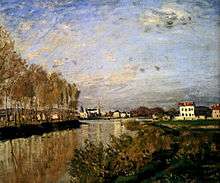
Argenteuil was founded as a convent in the 7th century (see Pierre Abélard and the Convent of Argenteuil). The monastery that arose from the convent was destroyed during the French Revolution.
A rural escape for Parisians, it is now a suburb of Paris. Painters made Argenteuil famous, including Claude Monet, Jean-Étienne Delacroix, Auguste Renoir, Gustave Caillebotte, Alfred Sisley and Georges Braque.
Personalities
- Kévin Mayer, athlete (decathlete)
- Fabien Ateba, basketball player
- Franck Beria, footballer
- Georges Braque, (1882-1963), sculptor and co-founder of cubism
- Ingrid Chauvin, (b. 1971), French actress
- Chevalier d'Argenteuil, (fl. in Newfoundland, Canada 1709-13), French soldier; he captured Fort William at St. John's, Newfoundland in 1709
- Sidney Duteil television host
- Ibrahim Gary, karateka
- Charles Longuet, journalist and socialist activist and his wife Jenny, daughter of Karl Marx
- Alexandre Ndoye, basketball player
- Cécile Pelous, philanthropist and designer
Transport
Argenteuil is served by two stations on the Transilien Paris – Saint-Lazare suburban rail line: Argenteuil and Val d'Argenteuil.
The French transport system is straightforward to navigate, so Argenteuil is also an ideal city where there is an extensive public transport system with stations in Argenteuil and Val d'Argenteuil, where the train stops at Transilien Paris. Saint-Lazare (line J).
Since redeveloped by STIF and SNCF, Argenteuil has been equipped with a new Paris-Saint-Lazare-Ermont-Eaubonne line. The new line was launched in 2006, adding the Paris-Saint Lazare / Cormeilles-en-Parisis - Pontoise / Mantes-la-Jolie service to Paris for about ten minutes.
By Bus* :[2]
361 Gare d'Argenteuil à Gare de Pierrefitte - Stains RER;
140 Gare d'Argenteuil - Asnières-Gennevilliers - Gabriel Péri;
164 Argenteuil - Claude Monet College - Porte de Champerret;
By train* :
Gare d'Argenteuil (SNCF-J): Paris Saint-Lazare in 15 minutes and Colombes in 4 minutes
Gare Saint-Gratien (T-8): Porte Maillot in 22 minutes
Épinay Orgemont (T-8): Gare Saint-Denis in 20 minutes
Travel by car:
City Center: 10 minutes;
Paris Saint-Lazare: 25 minutes
La Défense: 20 minutes;
Colombes: 10 minutes;
la Plaine-Saint-Denis: 18 minutes;
Porte de Clichy: 15 minutes;
Education
As of 2016 the commune's schools have over 12,000 students. The commune has:[3]
- 30 public preschools (maternelles) and one private elementary school with a preschool[4]
- 26 public and 2 private elementary schools[5]
- 11 junior high schools (collèges) - 10 public and 1 private[6]
- 6 senior high schools/sixth-form colleges:[7]
- Lycée Georges Braque
- Lycée Cognacq-Jay
- Lycée Julie-Victoire Daubié
- Lycée Jean Jaurès
- Lycée Fernand et Nadia Léger
- Ecole nationale des professions de l'automobile (private)
Paris 13 University serves as the area university.[8]
The Conservatoire à rayonnement départemental de Musique, Danse et Théâtre is located in Argenteuil.[9] André Bon is one of its former students.
Population
| Historical population | ||||||||||||||||||||||||||||||||||||||||||||||||||||||||||||||||||||||||||||||||||||||||||||||||||||||||||||||||||||
|---|---|---|---|---|---|---|---|---|---|---|---|---|---|---|---|---|---|---|---|---|---|---|---|---|---|---|---|---|---|---|---|---|---|---|---|---|---|---|---|---|---|---|---|---|---|---|---|---|---|---|---|---|---|---|---|---|---|---|---|---|---|---|---|---|---|---|---|---|---|---|---|---|---|---|---|---|---|---|---|---|---|---|---|---|---|---|---|---|---|---|---|---|---|---|---|---|---|---|---|---|---|---|---|---|---|---|---|---|---|---|---|---|---|---|---|---|
|
|
| ||||||||||||||||||||||||||||||||||||||||||||||||||||||||||||||||||||||||||||||||||||||||||||||||||||||||||||||||||
Immigration
| Born in Metropolitan France | Born outside Metropolitan France | |||
|---|---|---|---|---|
| 77.5% | 22.5% | |||
| Born in Overseas France |
Born in foreign countries with French citizenship at birth1 | EU-15 immigrants2 | Non-EU-15 immigrants | |
| 2.1% | 2.1% | 4.3% | 14.0% | |
| 1 This group is made up largely of former French settlers, such as pieds-noirs in Northwest Africa, followed by former colonial citizens who had French citizenship at birth (such as was often the case for the native elite in French colonies), and to a lesser extent foreign-born children of French expatriates. Note that a foreign country is understood as a country not part of France in 1999, so a person born for example in 1950 in Algeria, when Algeria was an integral part of France, is nonetheless listed as a person born in a foreign country in French statistics. 2 An immigrant is a person born in a foreign country not having French citizenship at birth. Note that an immigrant may have acquired French citizenship since moving to France, but is still considered an immigrant in French statistics. On the other hand, persons born in France with foreign citizenship (the children of immigrants) are not listed as immigrants. | ||||
Famous paintings of Argenteuil

- By Claude Monet:
Autumn at Argenteuil, Regatta at Argenteuil, Red Boats, Argenteuil, The Bridge at Argenteuil, The Port at Argenteuil, The Seine at Argenteuil, View of Argenteuil-Snow, Bords de la Seine a Argenteuil, and Snow at Argenteuil. And ’’Train in snow at Argenteuil’’.
- By other painters:
Argenteuil and Seine near Argenteuil by Édouard Manet, Regatta at Argenteuil by Pierre-Auguste Renoir, and The Bridge in Argenteuil by Gustave Caillebotte.
Gallery
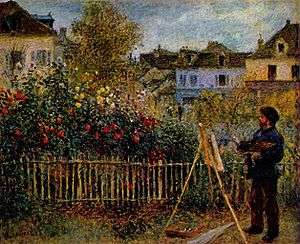
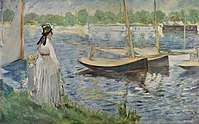 Édouard Manet, The Seine near Argenteuil, 1874
Édouard Manet, The Seine near Argenteuil, 1874 Claude Monet, The Seine at Argenteuil, 1874
Claude Monet, The Seine at Argenteuil, 1874 Édouard Manet, Argenteuil, 1875
Édouard Manet, Argenteuil, 1875 Claude Monet, Bords de la Seine à Argenteuil, 1875
Claude Monet, Bords de la Seine à Argenteuil, 1875
References
- INSEE
- Association of Mayors of the Val d’Oise (in French)
- "Populations légales 2017". INSEE. Retrieved 6 January 2020.
- "Acheter l'appartement Argenteuil - La Ville" (in French). Retrieved 2018-06-02.
- "établissements scolaires." Argenteuil. Retrieved on September 6, 2016. "Plus de 12 000 élèves prennent le chemin de l’école tous les matins."
- "Les maternelles." Argenteuil. Retrieved on September 6, 2016.
- "Liste des écoles élémentaires d'Argenteuil." Argenteuil. Retrieved on September 6, 2016.
- "Les collèges." Argenteuil. Retrieved on September 6, 2016.
- Home. Argenteuil. Retrieved on September 6, 2016.
- "Université Paris 13 Archived 2016-09-15 at the Wayback Machine." Argenteuil. Retrieved on September 6, 2016.
- "Argenteuil Conservatory". Archived from the original on 2008-11-18. Retrieved 2009-08-28.
- "Springtime". The Walters Art Museum.
External links
| Wikimedia Commons has media related to Argenteuil. |
- Official website (in French)
- Official facebook (in French)